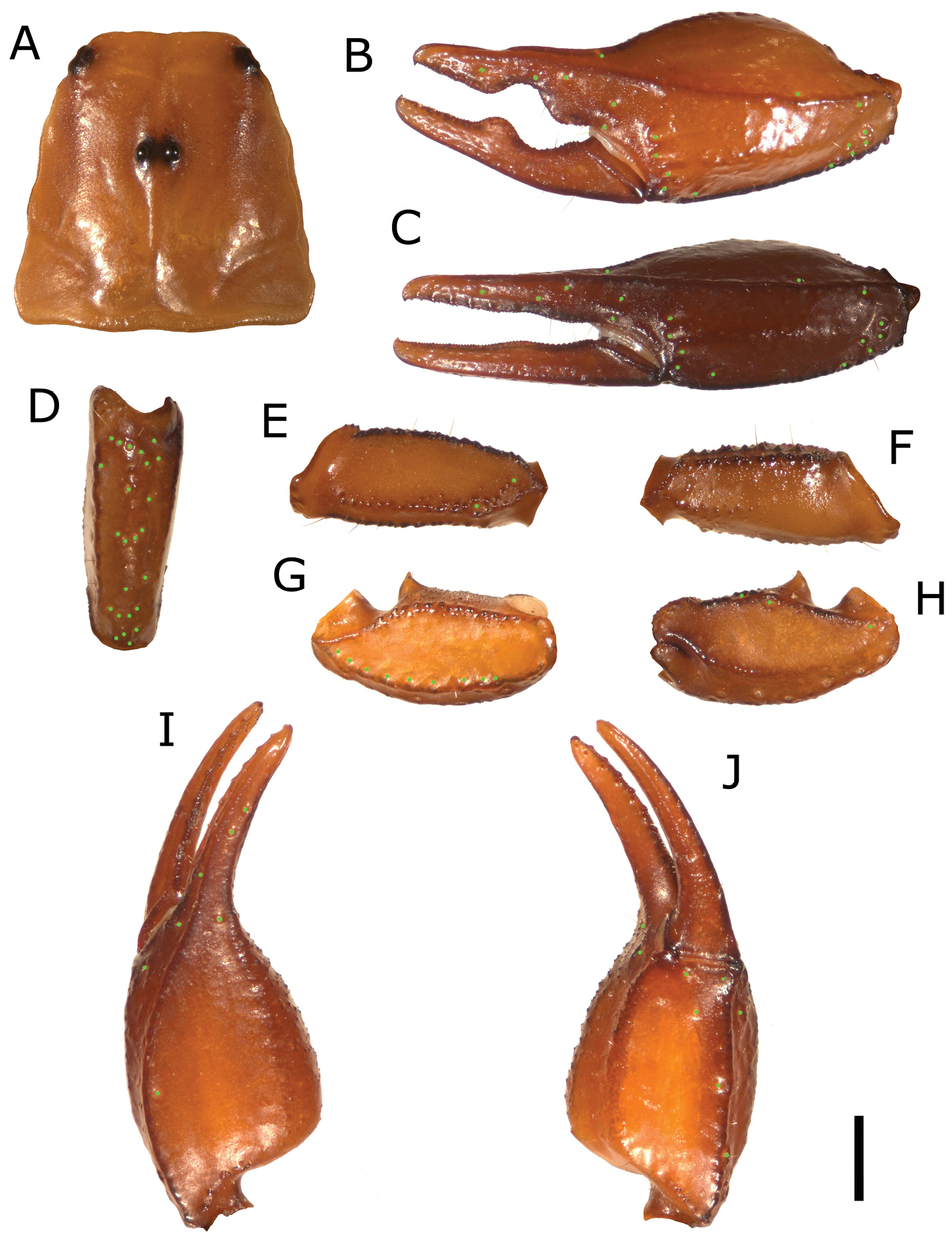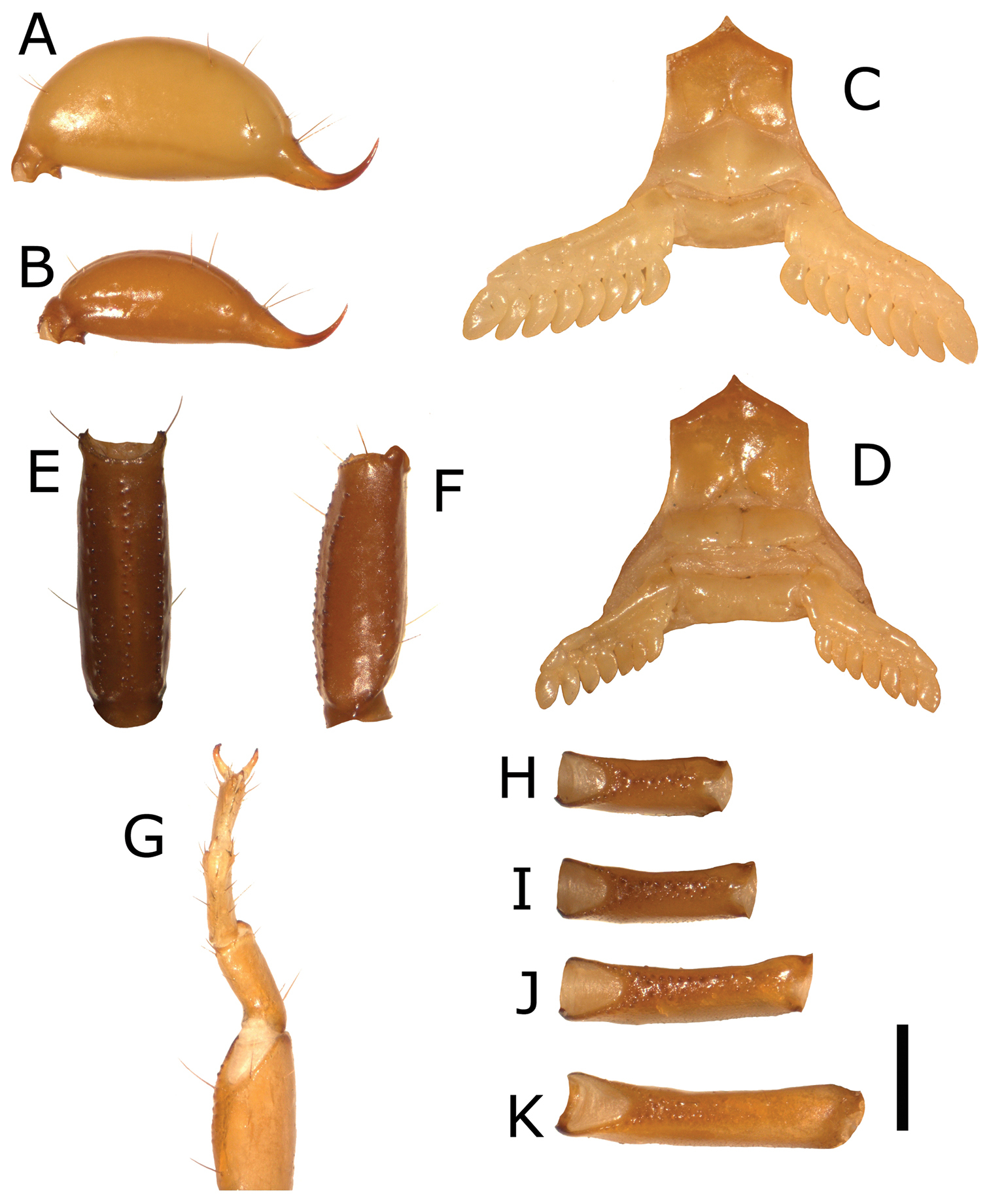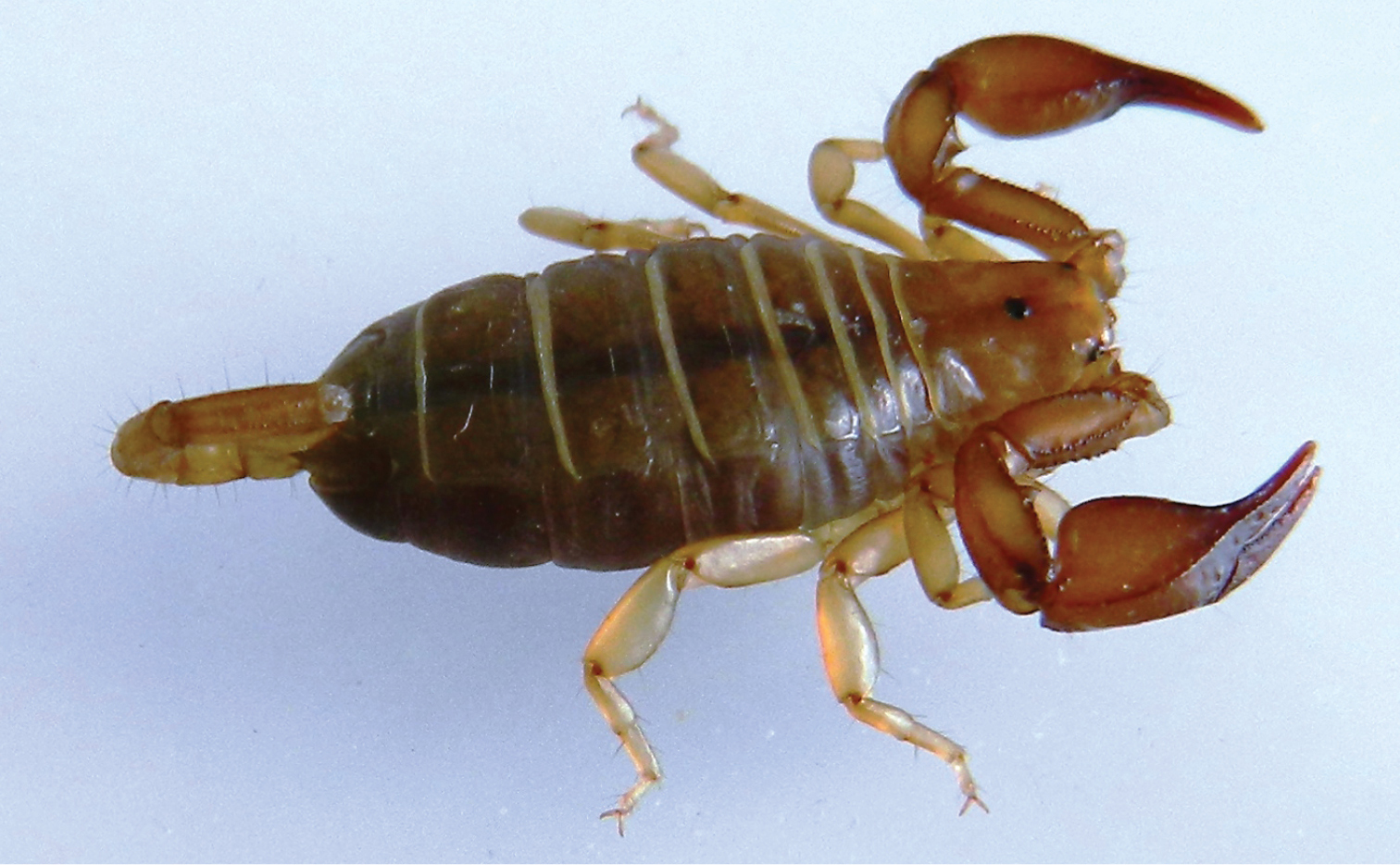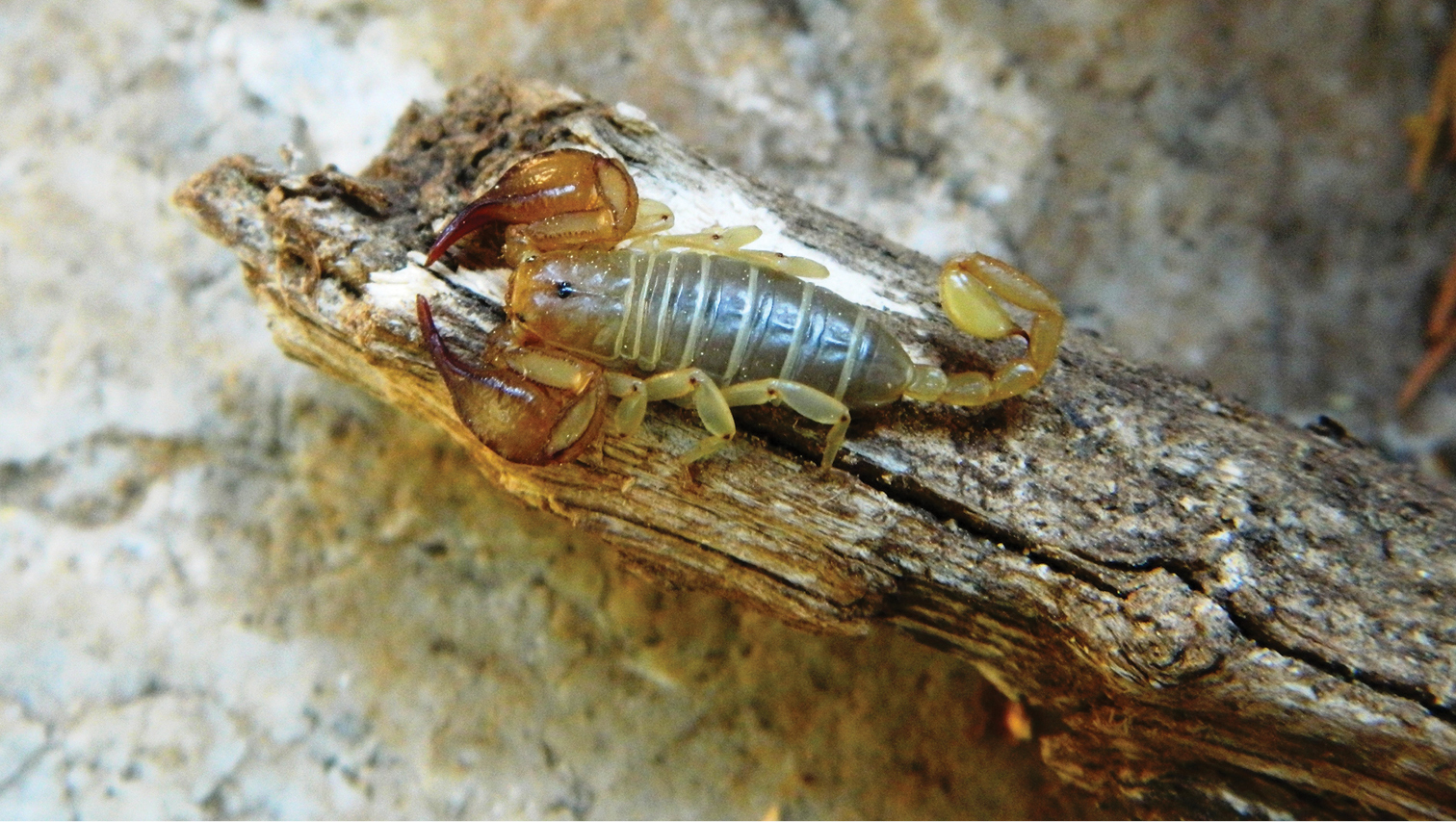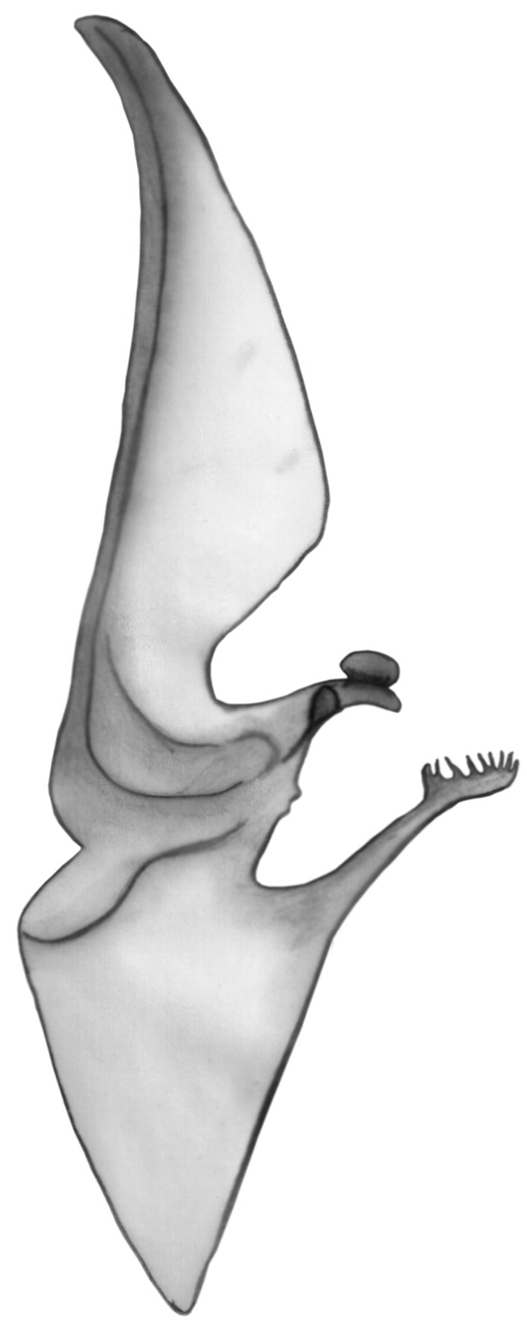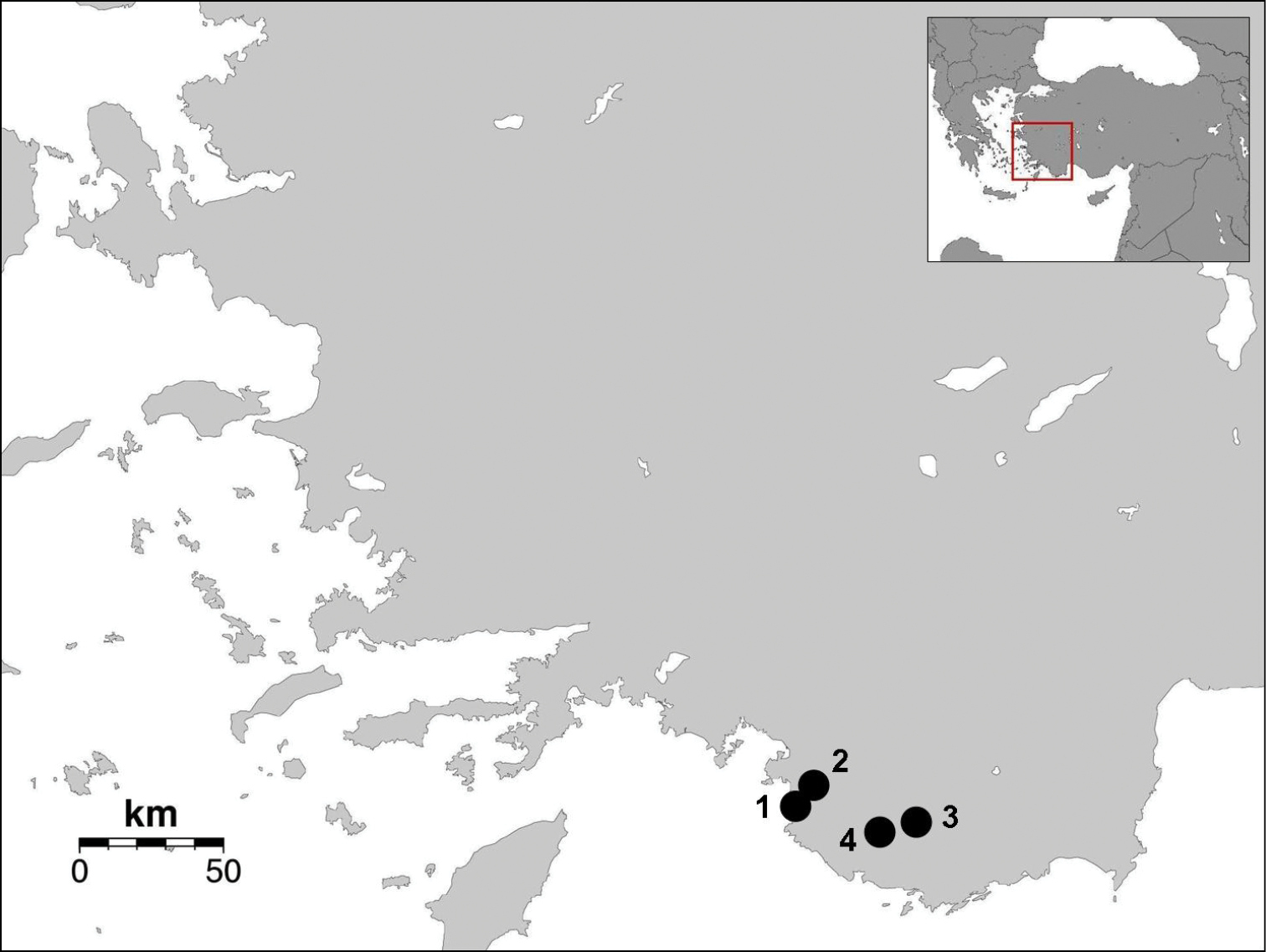






(C) 2013 Ersen Aydın Yağmur. This is an open access article distributed under the terms of the Creative Commons Attribution License 3.0 (CC-BY), which permits unrestricted use, distribution, and reproduction in any medium, provided the original author and source are credited.
For reference, use of the paginated PDF or printed version of this article is recommended.
Citation: Yağmur EA, Tropea G, Yeşilyurt F (2013) A new species of Euscorpius Thorell, 1876 (Scorpiones, Euscorpiidae) from south western Turkey. ZooKeys 348: 29–45. doi: 10.3897/zookeys.348.5943
A new scorpion species, Euscorpius lycius sp. n., is described based on specimens collected from Muğla and Antalya Provinces, in southwestern Turkey. It is characterized by a standard trichobothrial pattern (Pv=8/9, et=6, em=4, eb=4), small size and light brown/reddish coloration. With the description of Euscorpius lycius sp. n., the number of valid species of the genus Euscorpius in Turkey increases to 5.
Scorpion, Euscorpius, new species, Turkey
The genus Euscorpius Thorell, 1876 is one of the most studied taxa of scorpions; however, because of its complexity, its taxonomy changes continuously and is not completely clear. The Euscorpius populations of Turkey have been poorly studied, but in the last years several studies are delineating the diversification and distribution of the various forms of this genus (e.g.
Presence of the subgenus Euscorpius in Turkey have been reported many times under the name of Euscorpius carpathicus or Euscorpius carpathicus “complex”, from İstanbul (
The new species described herein, Euscorpius lycius sp. n., is the third species recognizedin Turkey which “falls” in the subgenus Euscorpius as it is understood until now; however, in the present study we do not assign a subgeneric level, since that the subgenus Euscorpius currently needs depth studies and new dichotomous keys as has been shown in
A total of 26 specimens belonging to the new species were collected from Antalya and Muğla Province, in the south-west of Turkey (Fig. 8). Most of specimens were collected in night time from under pine forest while they were siting on the rocks, cracks and garden walls. Some specimens were collected from under stones in pine forests in day time. Comparison material: Euscorpius avcii, holotype ♂, Dilek Peninsula National Park, Canyon, Dilek Peninsula, near Davutlar Town, Kuşadası, Aydın, Turkey, 07.10.2005, leg. H. Koç (MTAS); paratypes, 1 ♂, 5 ♀♀, Dilek Peninsula National Park, Canyon, Dilek Peninsula, near Davutlar Town, Kuşadası District, Aydın Province, Turkey, 07.10.2005, leg. H. Koç (MZUF); same data, 1 ♂, 2 ♀♀ (GTC); Abbreviations: V: trichobothria on ventral pedipalp chela manus; Pv: trichobothria on patella ventral surface; Pe: trichobothria on the pedipalp patella external surface; et: external terminal; est: external subterminal; em: external medium; esb: external suprabasal; eba: external basal a; eb: external basal; DPS: dorsal patellar spur; DD: distal denticle; MD: median denticles; OD: outer denticles; ID: inner denticles; IAD: inner accessory denticles. Material examined is deposited in the following collections: MZUF: Museo Zoologico ‘La Specola’ dell’Università di Firenze, Florence, Italy; GTC: private collection of Gioele Tropea, Rome, Italy; MTAS: Museum of the Turkish Arachnological Society; MSNB: Museo Civico di Scienze Naturali “E. Caffi”, Bergamo, Italy; ZMSU: Zoology Museum of Sinop University, Turkey; KUAM: Arachnological Museum of Kırıkkale University, Turkey; AZM: Zoology Museum of Alaşehir Vocational School, Celal Bayar University, Manisa, Turkey.
The trichobothrial notations follow
http://zoobank.org/2146A862-414B-4EB7-9FEE-B5CF2B973395
http://species-id.net/wiki/Euscorpius_lycius
Figs 1–7Holotype: 1) 1♂, Turkey, Muğla Province, Fethiye District, Faralya Village, 30.05.2012, 36°29'37"N, 29°08'07"E, 349 m, leg. F. Yeşilyurt & E. A. Yağmur (AZM).
Paratypes: 1) 3♀♀, 4♂♂. Muğla Province, Fethiye District, Faralya Village, 30.05.2012, 36°29'37"N, 29°08'07"E, 349 m, leg. F. Yeşilyurt & E. A. Yağmur (KUAM). Same data but 1♀, 1♂ (AZM) 2♀, 2♂ (GTC) 1♀, 1♂ (MSNB).
2) 1♂. Muğla Province, Fethiye District, Babadağ Mountain, 26.06.2013, 36°28'58"N, 29°12'04" E, 1132 m, leg E. A. Yağmur, M. Kesdek & Y. İlemin (AZM).
3) 1♂. Antalya Province, Kaş District, Gömücü Village, 15.05.2012, 36°24'15"N, 29°42'01"E, 976 m, leg. R. Kaya & A. Akkaya (AZM).
4) 2 juv. Antalya Province, Kaş District, İkizce Village, 5 km North, 13.04.2012, 36°21'30"N, 29°29'00"E, 1140 m, leg. E. A. Yağmur & D. Türk (AZM). Same data but 02.06.2012, 5♀♀, 1♂ (AZM), leg. E. A. Yağmur, M. Örgel & D. Türk (Fig. 8).
Measurements (in mm) of male holotype and female paratype of Euscorpius lycius sp. n.
| Holotype ♂ | Paratype ♀ | ||
|---|---|---|---|
| Total | Length | 21.14 | 20.91 |
| Carapace | Length | 3.06 | 3.48 |
| Posterior width | 3.12 | 3.42 | |
| Metasoma | Length | 7.94 | 7.17 |
| Segment I | Length | 0.98 | 0.96 |
| Width | 1.08 | 1.08 | |
| Segment II | Length | 1.20 | 1.17 |
| Width | 0.91 | 0.95 | |
| Segment III | Length | 1.36 | 1.32 |
| Width | 0.87 | 0.87 | |
| Segment IV | Length | 1.63 | 1.26 |
| Width | 0.84 | 0.83 | |
| Segment V | Length | 2.76 | 2.46 |
| Width | 0.84 | 0.83 | |
| Telson | Length | 3.24 | 2.64 |
| Vesicle | Length | 2.52 | 1.86 |
| Width | 1.20 | 0.90 | |
| Height | 1.26 | 0.84 | |
| Aculeus | Length | 0.72 | 0.78 |
| Femur | Length | 2.61 | 2.82 |
| Width | 0.95 | 1.08 | |
| Patella | Length | 2.58 | 2.82 |
| Width | 1.02 | 1.23 | |
| Chela | Length | 5.10 | 5.58 |
| Width | 1.86 | 1.98 | |
| Movable finger | Length | 2.70 | 3 |
The specific epithet refers to the ancient Latin name of the collection area, which is Lycia.
A small Euscorpius species, total length 21–25 mm. Color of adults light brown-reddish with carapace and pedipalps darker. The number of trichobothria on the pedipalp manus ventral surface is 4 (3 V+Et 1); the number of trichobothria on the pedipalp patella ventral surface usually is 9 (in 86.54% of examined pedipalps); the number of trichobothria on pedipalp patella external surface usually is: eb=4, eba=4, esb=2, em=4, est=4, et=6–7 (et=6 in 53.84% and et=7 in 36.54% of examined pedipalps). The pectinal teeth count usually is 8 (8 in 66.66% and 9 in 29.16% of examined pectines) in males and 7 in females. Dorsal carinae of the metasomal segments I–IV granulated. Chela with a notch on fixed finger and scalloping of the movable finger in adult males, obsolete in females. Trichobothrium et occurs distally to the notch on the fixed finger, est occurs above the notch on the fixed finger and dsb occurs proximally to the notch of the fix finger.
Coloration: Very light brown-reddish with carapace and pedipalps darker. Granules on the femora of the legs, especially ventrally, dark. The sternites, pectines and genital operculum are very light brownish-whitish.
Carapace. Length 3.06 mm; posterior width 3.12. Finely granulated. Distance from the center of the median eyes to the anterior margin of the carapace is 39.21% of the prosoma; the length from the center of the median eyes to the posterior margin of the carapace is 60.79% of the prosoma. Length/Posterior width ratio 0.981 (Fig. 1A).
A carapace B external view of chela of the adult male C external view of chela of the adult female D external view of pedipalp patella E dorsal view of pedipalp femur F ventral view of pedipalp femur G ventral view of pedipalp patella H dorsal view of pedipalp patella I dorsal view of chela J ventral view of chela. (Scale bar=1 mm).
Mesosoma. Tergites finely granulated; sternites smooth. The area of overlap between the sternites is lighter in color. Pectinal teeth count is 9–9. The spiracles are very small and little visible, oval-shaped and it is inclined about 45° downwards towards outside.
Metasoma. Medium size with respect to body length. Dorsal carinae of segment I-IV are granulated, obsolete on the segment V; ventromedian carinae of segment I-III absent, barely visible angularities on the IV, ventromedian carinae on segment V granulated; ventrolateral carinae of segment I absent, on segments II and III obsolete, on segment IV formed by small spaced granules, on segment V is formed by serrulate granules (Fig. 2E, F).
A telson of adult male B telson of adult female C sternopectinal area of adult male D sternopectinal area of adult female E ventral view of the metasomal segment V F lateral view of the metasomal segment V G tarsus and basitarsus H leg femur I I leg femur II J leg femur III K leg femur IV. (Scale bar=1 mm).
Telson. Vesicle weakly swollen; smooth, with ventral setae of different sizes; telson height 1.26; telson length 3.24; vesicle length 2.52; vesicle width 1.20; L/H ratio of the vesicle 2 (Fig. 2A, B).
Pectines. Pectinalteeth count 9-9; middle lamellae count 5-5.
Genital operculum. Partially divided with genital papillae protruding.
Sternum. Pentagonal shape, type 2. Length similar to width, deep posterior emargination.
Pedipalp. Coxa and trochanter granulated. Femur: dorsal internal carinae formed by large dark tubercles;dorsal external carinae formed by slightly serrulated and spaced tubercles; intercarinal spaces uniformly granulated with fine granules; external median carinae serrulate; anterior median carinae formed by conical big dark tubercles (Fig. 1E, F). Patella length 2.58; patella width 1.02; dorsal internal carinae dark and crenulate with few larger tubercles distally; dorsal and ventral external carinae rough; ventral internal carinae dark and tuberculate; dorsal intercarinal tegument very finely granulated; ventral intercarinal tegument almost smooth with a few scattered very small granules; internal intercarinal tegument uniformly finely granulate. Dorsal patellar spur well developed (Fig. 1G, H). Chelal carina D1 isdistinctly strong, a bit darker and from smooth to rough; D4 little marked, roughly smooth with a few very low granules; V1 isdistinctly strong, rough and dark; V3 with a few scattered very minuscule granules; external carina rough; intercarinal tegument from smooth to rough except between carinae D4 and V3, granulate. Movable finger dentition: MD form a straight line of very small denticles closely spaced with a DD on the distal tip; OD formed of 7 denticles on movable finger and 6 denticles on fixed finger, immediately outside of MD, their size increases progressively but the terminal denticle is not very pronounced; ID formed of 7 denticles on movable finger and 6 denticles on fixed finger, spaced from MD, their size increases progressively but the terminal denticle is not very pronounced; IAD on both movable and fixed finger formed of 4 small denticles; L/W ratio of the chela 2.74 (Fig. 1I, J)
Trichobothria. Chela trichobothria series V standard: V=4/4 (3 V+Et 1); patella ventral (Pv): 9/9; Patella external (Pe): et=5/6, est=4/4, em=4/4, esb=2/2, eba=4/4, eb=4/4.
Legs. legs with two pedal spurs. Tarsal ventral row with 10-14 spinules (including the ventral distal spinule); 3 flanking pairs of tarsal setae adjacent to the ventral spinules row. Little marked granulation present above leg femora, a bit more marked on III leg; dark conical tubercles on ventral leg femora.
Chelicerae. smooth, without marbling, uniformly coloured; typical dentition pattern of Euscorpius genus (
Variation. The variation observed in 26 studied specimens (12 males, 14 females) is as follows (left/right asymmetry not specified). Pectinal teeth in males (n=12): 7/8 (1), 8/8 (6), 8/9 (3), 9/9 (2); 8 in 66.66% and 9 in 29.16%; mean=8.25, SD=0.52. Pectinal teeth in females (n=14): 7/7 (12), 8/7 (2); 7 in 92.28% and 8 in 7.72%; mean=7.07, SD=0.26. Pedipalp patella trichobothria Pv (n=26): 9/10 (1), 9/9 (20), 8/9 (4), 8/8 (1); 9 in 86.54 % and 8 in 11.54 %; mean=8.90, SD=0.35. Pedipalp patella trichobothria Pe (n=26): et=?/6 (1), 5/6 (3), 6/6 (12), 7/7 (9), 7/8 (1); 6 in 54.90 % and 7 in 37.25 %; mean=6.35, SD=0.56. est=4/4 (26); em=4/3 (3), 4/4 (23); esb=2/2 (26); eba=4/3 (2), 4/4 (24); eb=3/4 (1), 4/4 (25). The telson vesicle in males is more swollen than in females: average L/H ratio of the vesicle is 1.93 in male and 2.28 in females. Dorsal patellar spur well developed. Average value of the length from center median eyes to anterior margin of the carapace is 40.30% of the carapace length. Average value of the length from center median eyes to posterior margin of the carapace is 59.70% of the carapace length.
Hemispermatophore. Were checked both right and left hemispermatophore of 5 specimens. Well developed lamina with well developed basal constriction, tapered distally; truncal flexure present and well developed; capsular lobe complex well developed, with acuminate process; ental channel spinose distally, exhibiting 8–11 tines in its crown (Fig. 7). The number of tines of the crown may be different between the right and the left hemispermatophore.
Dorsal and ventral views of Euscorpius lycius sp. n. male.
Dorsal and ventral views of Euscorpius lycius sp. n. female.
An alive female specimen of Euscorpius lycius sp. n.
A male Euscorpius lycius sp. n. in its natural habitat.
Left hemispermatophore of Euscorpius lycius sp. n.
Sampling map of Euscorpius lycius sp. n. 1 Muğla, Faralya Village 2 Muğla, Babadağ Mountain 3 Antalya, Gömücü Village 4 Antalya, İkizce Village.
Pectinal tooth and trichobothrial counts of Euscorpius species discussed in this paper. Between the brackets are the values most found.
| Species | Dp ♂ | Dp ♀ | Pv | Pe-et | Pe-est | Pe-em | Pe-esb | Pe-eba | Pe-eb |
|---|---|---|---|---|---|---|---|---|---|
| Euscorpius lycius sp. n. | 8 | 7 | 9 | 6–7 | 4 | 4 | 2 | 4 | 4 |
| Euscorpius avcii | 8 | 7 | 7 | 5–6 (5) | 4 | 4 | 2 | 4 | 4 |
| Euscorpius rahsenae | 9 | 7 | 8 | 5–6 (6) | 4 | 4 | 2 | 4 | 4 |
| Euscorpius candiota | 8–9 | 7 | 9-10 | 6–7 | 4 | 4 | 2 | 4 | 4 |
| Euscorpius ossae | 9 | 7 | 7–8 (7) | 5–6 (5) | 4 | 4 | 2 | 4 | 4 |
| Euscorpius koschewnikowi | 8 | 6–7 | 8 | 5–6 | 4 | 4 | 2 | 4 | 4 |
| Euscorpius scaber | 10–11 | 8 | 8 | 5–6 (6) | 4 | 4 | 2 | 4 | 4 |
| Euscorpius carpathicus aegaeus | 9 | 8 | 8 | 6 | 4 | 4 | 2 | 4 | 4 |
Pectinal tooth and trichobothrial serie Pv and Pe-et counts of Euscorpius species discussed in this paper: max-min (average) {number of pectines and pedipalps examined}.
| Species | Dp ♂ | Dp ♀ | Pv | Pe-et |
|---|---|---|---|---|
| Euscorpius lycius sp. n. | 7–9 (8.25) {24} | 7–8 (7.07) {28} | 8–10 (8.90) {52} | 5–7 (6.35) {51} |
| Euscorpius avcii | 7–9 (8.07) {58} | 6–7 (6.79) {100} | 6–8 (7.04) {158} | 5–6 (5.36) {158} |
| Euscorpius rahsenae | 8–10 (8.91) {36} | 6–9 (7.20) {82} | 7–9 (7.89) {118} | 5–6 (5.78) {118} |
| Euscorpius candiota | 8–9 (8.60) {16} | 5–8 (6.87) {28} | 8–10 (9.44) {46} | 5–7 (6.52) {46} |
| Euscorpius ossae | 8–10 (9.07) {14} | 6–8 (7.25) {40} | 6–9 (7.29) {55} | 4–6 (5.36) {55} |
| Euscorpius scaber | 9–13 (10.53) {53} | 6–10 (7.85) {212} | 7–10 (7.96) {273} | 4–8 (5.86) {257} |
| Euscorpius carpathicus aegaeus | 9–10 (9.16) {6} | 8 (8.00) {4} | 7–8 (7.9) {10} | 5–6 (5.9) {10} |
Euscorpius lycius sp. n. is “related” to the subgenus Euscorpius as it is understood until now, thus clearly distinguished from Euscorpius italicus and Euscorpius mingrelicus. However, in the present study we do not assign the subgeneric level, since that the subgenus Euscorpius currently needs depth studies and new dichotomous keys as has been shown in
Euscorpius avcii was described from Dilek Peninsula as an oligotrichous, small Euscorpius, with a length of 24–28 mm, light brown to brown-reddish colored with the carapace and pedipalps darker, and legs and telson lighter (
Euscorpius rahsenae was described from Marmara Region as a medium sized Euscorpius, total length 27–34 mm, color very light brown-yellowish with carapace and pedipalps a little darker, legs, telson and chelicerae lighter (
Below, we compare Euscorpius lycius sp. n. with some other forms present in the Aegean area: Euscorpius sicanus (C. L. Koch, 1837) complex; Euscorpius koschewnikowi Birula, 1900; Euscorpius candiota Birula, 1903; Euscorpius scaber Birula, 1900; Euscorpius ossae Di Caporiacco, 1950; and Euscorpius carpathicus aegaeus Di Caporiacco, 1950.
Euscorpius sicanus complex is widespread in mainland Greece and some Aegean islands (
Euscorpius koschewnikowi is a medium to large sized species (up to 46 mm), medium to dark brown in color, slender appearance with well developed dorsal patellar spur and all metasoma segments longer than wide. In addition, according to
Euscorpius candiota differs from Euscorpius lycius sp. n. for: (1) the metasomal carinae on segments II–IV smooth to obsolete (
Euscorpius scaber is a scorpion from the northern Aegean area, it is distinguished from Euscorpius lycius sp. n. by (1) a higher number of pectinal teeth, Dp 10/11 in males and 8 in females (
Euscorpius ossae is an oligotrichous species, dark brown in colour with lighter legs and telson. It was described from Mount Ossa, in Thessaly. This form can be distinguished from Euscorpius lycius sp. n. mainly by Pv=7 and et=5, compared to Pv=9 and Pe-et=6–7 (generally 6) and its dark colour.
Euscorpius carpathicus aegaeus is a light colored form described from the island of Antiparos, in the central-southern part of the Aegean Sea. It is probably endemic in few islands in the central-south Aegean Sea. In addition, it is described as uniformly light yellow in colour and females with a pectinal teeth count of 8 with metasomal segments almost smooth (
The specimens of Euscorpius lycius sp. n. were collected between 349 and 1140 m a.s.l. Most of the specimens were collected in night time in the pine forest while they were siting on the rocks, cracks and garden walls. The remaining specimens were collected in day time from under stones in pine forests.
Euscorpius lycius sp. n. specimens from Faralya Village were collected on wall stones and garden walls humid in shady places with a lot of stones covered by moss (Fig. 10). This place is at the top of high rocky wall and very close to sea. Other specimens were collected from red pine (Pinus brutia Ten.) and Lebanon cedar (Cedrus libani A. Rich.) forest that also includes kermes oak bushes (Quercus coccifera L.), in Gömücü Village and İkizce Village (Antalya Province). These two areas have high elevation, are always cool and are located about ten kilometers from the sea. Babadağ Mountain (Muğla Province) locality has same ecological features with these localities. Therefore these three localities are always humid, they include stones covered by moss.
All localities are humid and cool, with calcareous stones covered with moss, where the specimens of Euscorpius lycius sp. n. were usually found. We observed that specimens prefer cracks of mossy rocks (Fig. 9). We accept the presence of moss as an indicator during our field trips. Areas with moss are potential places where to find specimens of Euscorpius.
The forest habitat in İkizce Village.
Habitat in Faralya Village.
Taxonomy of Euscorpius genus is complicated and still unresolved throughout its range, because of type specimens lost, lack of specimens from many areas and existence of cryptic species complex, which exhibiting the same, or very similar, standard characters.
The species described herein, Euscorpius lycius sp. n., is one of those forms of Euscorpius with standard characters shared by several species. This condition of cryptic species complex, is known throughout the range of the genus Euscorpius, however it is much more expressed in the band that includes Greece and western Turkey. Additional morphological features that simplify the division between the species of the genus Euscorpius should be found, but at the moment the only way to identify the various species is to combine a set of characters, primary and secondary, the area of origin and a certain number of specimens available.
Further studies are in progress to understand the quantity and distribution of the different species and populations of the genus Euscorpius in Turkey and their relationship with the Greek populations.
With the description of Euscorpius lycius sp. n., the number of valid species of the genus Euscorpius in Turkey increases to 5.
We wish to thank Dr. Rahşen S. Kaya, Dr. Abdulmuttalip Akaya, Dr. Memiş Kesdek, Dr. Yasin İlemin, Mr. Semih Örgel and Mr. Deniz Türk for their help during the field trips and specimen collecting.
